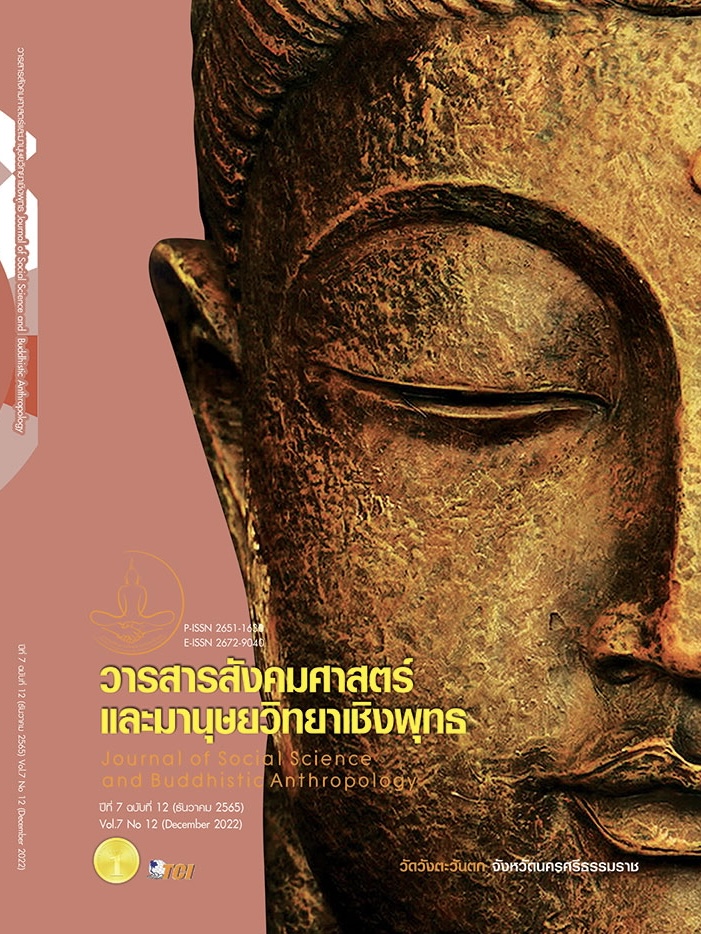RESEARCH SYNTHESIS ON THAI BELIEFS ABOUT THE TEETH FOLLOWING THE EASTERN AND WESTERN CONCEPTS
Keywords:
Research Synthesis, Thai Beliefs, Tooth, Eastern Concepts, Western ConceptsAbstract
The objectives of this study were to 1) synthesise the research on Thai beliefs about the teeth following the Eastern and Western concepts and 2) evaluate and propose a diagram for Thai beliefs about the teeth following the Eastern and Western concepts. The research method was qualitative research based on systematic synthesis. The research instrument divided the data collection in the research process into four steps: 1) Data collection by adopting documentary research 2) Data analysis stage 3) Data synthesis stage 4) Evaluation and Presentation stage. The research results show that the studies on Thai beliefs about teeth follow Eastern and Western concepts. The selected articles found 27 out of 591 articles were found to match the selected criteria. It revealed that Thai beliefs about the teeth following the Eastern concepts were mainly from Buddhism's concepts and the beliefs about the rite. The Western concepts were primarily from the Theory of Planned Behavior (TPB) model and the Health Belief Model (HBM) based on an individual's perception and experience. The synthesis of this article is presented as a diagram. It can be applied to understand social science research. The findings could be explained how religion and rituals passed down from the ancestors have shaped the beliefs of Thai people today. According to Western society, comparing and looking at teeth in science often occurs due to gaining knowledge and experience. Western knowledge, perceptions and experience lead to practice in caring for one's oral and dental health. Finally, gather and pass on the information to family members. The recommendation is to continue quantitative and qualitative research to clarify concepts and theories following the Western and Eastern in explaining Thai beliefs about teeth for further study in Thai studies and social science.
References
กฤษฎา นันทเพ็ชร. (2560). ห้องสุขา: มุมมองระบบสุขภาพเชิงพุทธ. Journal ofEducational Review Faculty of Education in MCU, 4(2), 83-92.
ณรงค์ฤทธิ์ สุมาลี. (2558). ข้อสังเกตเชิงแนวคิดว่าด้วยพลวัตความเป็นท้องถิ่นอีสานในบริบทของสังคมสมัยใหม่ : มองผ่านปฏิบัติการทางสังคมและโครงสร้างสังคมของความเชื่อผี ปู่ตาและผีคุ้มครอง. วารสารวิชาการแพรวากาฬสินธุ์ มหาวิทยาลัยราชภัฏกาฬสินธุ์, 2(2), 26-51.
ทำนอง วงศ์พุทธ และคณะ. (2559). ความเชื่อร่วมเรื่องเครื่องรางของขลังในเมืองชายแดนไทย - ลาว - กัมพูชา. วารสาร ศิลปศาสตร์ มหาวิทยาลัย อุบลราชธานี, 12(1), 307- 331.
พระครูรัตนญาณ โสภิต และคณะ. (2562). ความเชื่อในประเพณีแซนโฎนตาของจังหวัดบุรีรัมย์. Dhammathas Academic Journal, 19(3), 285-294.
พระชลญาณมุนี นาคสิทธิเลิศ. (2564). ปรากฏการณ์ทางความเชื่อของคนไทย ในยุค ปัจจุบัน. วารสารวิทยาลัยสงฆ์นคร ลำปาง, 10(3), 250-265.
พระสำรอง สญฺญโต. (2563). การศึกษาความสำคัญของมูลกัมมัฏฐานในกายคตาสติสูตร. วารสารสังคมศาสตร์ ปัญญาพัฒน์, 2(1), 25-32.
พระแสงจันทร์ ฐิตสาโร และคณะ. (2562). ภูมิปัญญาท้องถิ่นกับความเชื่อทางพระพุทธศาสนา. Journal of Graduate Saket Review, 4(1), 12-20.
มนตรี วิวาห์สุข. (2554). แผนที่ครอบครัวในพระไตรปิฎก. พุทธจักรโลกร่มเย็นดับเข็ญได้ด้วยศาสนา, 65(1), 26-28.
รัศมี ชูทรงเดช. (2557). งานช่างฝีมือในยุคเหล็กของวัฒนธรรมโลงไม้ บนพื้นที่สูง ในอำเภอปางมะผ้า จังหวัดแม่ฮ่องสอน. ดำรง วิชาการ, 13 (1), 73-106.
วิราวรรณ สมพงษ์เจริญ. (2550). คติ ความเชื่อของคนไทยสมัย สุโขทัย พ. ศ. 1726 - พ. ศ.2006. ใน ดุษฎีนิพนธ์อักษรศาสตร์มหาบัณฑิต. มหาวิทยาลัย ศิลปากร.
สุภารัตน์ ชาญแท้ และคณะ. (2560). ศึกษาความเชื่อเกี่ยวกับ พระบรมธาตุเจดีย์ นครศรีธรรมราช. Academic MCU Buriram Journal, 2(2), 11-23.
Ajzen, I. . (1991). The theory of planned behavior. Organizational behavior and . human decision processes, 50(2), 179-211.
Buglar, M. E. et al. (2010). The role of self-efficacy in dental patients' brushingand flossing: testing an extended Health Belief Model. Patient education and counseling, 78(2), 269-272.
Hrubes, D. et al. (2001). Predicting hunting intentions and behavior: Anapplication of the theory of planned behavior. Leisure Sciences, 23(3), 165-178.
Jervis, R. (2006). Understanding beliefs. Political Psychology, 27(5), 641-663.
Österholm, M. (2010). Beliefs: A theoretically unnecessary construct? In Sixth Congress of the European Society for Research in Mathematics Education. In January 28th-February 1st 2009, Lyon, France (pp. 154-163). RecherchePédagogique: Institut National de .
Rahimi, F. et al. . (2011). Oral health care based on educational health beliefmodel in child. Journal of Health and Hygiene, 1(4), 74-81.
Ranathunga, G. M. et al. (2018). Headdress: Faith and practice in everyday life in Buddhism (The case of the temple of the tooth Buddhist religious activities and the cultural headdress of Sri Lanka). Journal of Advanced Research in Social Sciences and Humanities, 3(5), 172-178.
Siripipatthanakul, S. & Bhandar, M. (2021). A Qualitative Research FactorsAffecting Patient Satisfaction and Loyalty: A Case Study of Smile Family Dental Clinic. International of Trend in Scientific Research and Development , 5 (5), 877-896.
Siripipatthanakul, S. & Nyen Vui, C. (2021). Dental practice-related factors and patient loyalty in dental clinics, Laem Chabang, Thailand: The mediating role of patient satisfaction. International Journal of Behavioral Analytics, 1(2), 1-17.
Siripipatthanakul, S. (2011). Development of a Model for Administration of Development of a Model for Administration of. International Journal of Learning, 17(12), 137-150.
Downloads
Published
How to Cite
Issue
Section
License
Copyright (c) 2022 Journal of Social Science and Buddhistic Anthropology

This work is licensed under a Creative Commons Attribution-NonCommercial-NoDerivatives 4.0 International License.








